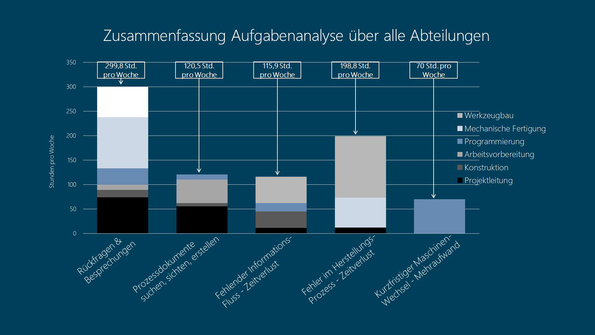Vermeiden Sie diese 10 Fehler bei der Fertigungsplanung
Die Planung der Fertigung fällt im Arbeitsalltag schnell mal unter den Tisch, was leicht zu Missverständnissen führt und doppelte Arbeit nach sich zieht. Schade, denn durch Planen lässt sich meist mit wenig Aufwand Vieles verbessern - und noch mehr dabei gewinnen.
"Obwohl wir so viel Zeit mit Planen verbringen, kommt es
bei der Projektabwicklung dauernd zu Nachfragen und Missverständnissen."
Auf solche und ähnliche Situationen treffe ich als MES-Berater bei Kunden bereits seit vielen Jahren. Daher möchte ich hier einmal typische Fehler bei der Fertigungsplanung nennen und so die Ursachen für Zeitverluste aufzeigen. Lernen Sie aus den Fehlern anderer. Unserer Erfahrung nach lassen sich viele einfach vermeiden, sofern klar ist, wo man ansetzen muss. Lesen Sie im Blog-Artikel, wo die Zeitfresser sitzen oder laden Sie sich gleich unser Merkblatt mit der Liste der häufigsten Fehler herunter.
Erfahrungswissen Einzelner reicht nicht
Woher Sie Zeit für's Planen nehmen
Laut einer Studie* realisieren erfolgreich planende Werkzeugbaubetriebe bis zu 85 Prozent ihrer erstellten Angebote. Es lohnt sich also, die Fertigungsplanung genauer zu betrachten - wie unser Kunde es mit einem Untersuchungsauftrag über alle Abteilungen tat. Er brachte ans Licht, dass die vermeintlich eingesparte Zeit durch minimierte Planung hauptsächlich in Improvisation floss.
Der größte Zeitfresser mit knapp 300 Stunden in der Woche waren Rückfragen und Besprechungen wegen Unklarheiten, Pannen und Änderungen. Besonders überraschend: Ganze 120 Stunden pro Woche nahmen das Suchen, Sichten und Sichern von Prozessdokumenten in Anspruch. Vor allem Projektleiter waren mit Rückfragen und Dokumentensuche beschäftigt. Wertvolle Zeit, die sie zum Planen hätten nutzen können.
*Studie „Erfolgreich Planen im Werkzeugbau“ durchgeführt von der Werkzeugbauakademie Aachen (WBA)
Systematisch digital entlasten
Manuelles Planen in Excel oder auf Plantafeln und Papier ist im Werkzeug- und Formenbau beliebt. Doch bei hoher Bauteilkomplexität, zahlreichen Änderungen, Engpässen oder großen Auftragsvolumina nehmen Umplanungen und Aktuell-Halten der Dokumente enorme Ausmaße an. Selbst erfahrene Fertigungsplaner gelangen an ihre Grenzen, sollen sie alle Schnittstellen und Abhängigkeiten dauerhaft im Auge behalten. Dann ist es sinnvoll, sie durch systematische Software-Unterstützung zu entlasten. Mit einer durchgängigen Software zur Planung und Steuerung der Fertigung, die jeden von der Geschäftsleitung bis zur Montage einbezieht, standardisieren und erleichtern Sie die Fertigungsplanung.
Die Vernetzung und Echtzeitdaten bieten stets aktuelle Übersichten - Sie sparen an unterschiedlichen Stellen viel Zeit.


Unser Blog-Autor:



